This exercise is excerpted from Noble Desktop’s Cinema 4D Lite training materials and is compatible with Cinema 4D updates through 2023. To learn current skills in Cinema 4D with hands-on training, check out our Cinema 4D in After Effects Bootcamp, Motion Graphics Certificate, and video editing classes in-person and live online.
Note: These materials are provided to give prospective students a sense of how we structure our class exercises and supplementary materials. During the course, you will get access to the accompanying class files, live instructor demonstrations, and hands-on instruction.
Topics covered in this Cinema 4D tutorial:
AE to C4D Integration, The Cineware Effect, The C4D Interface, C4D Tools
Exercise Preview
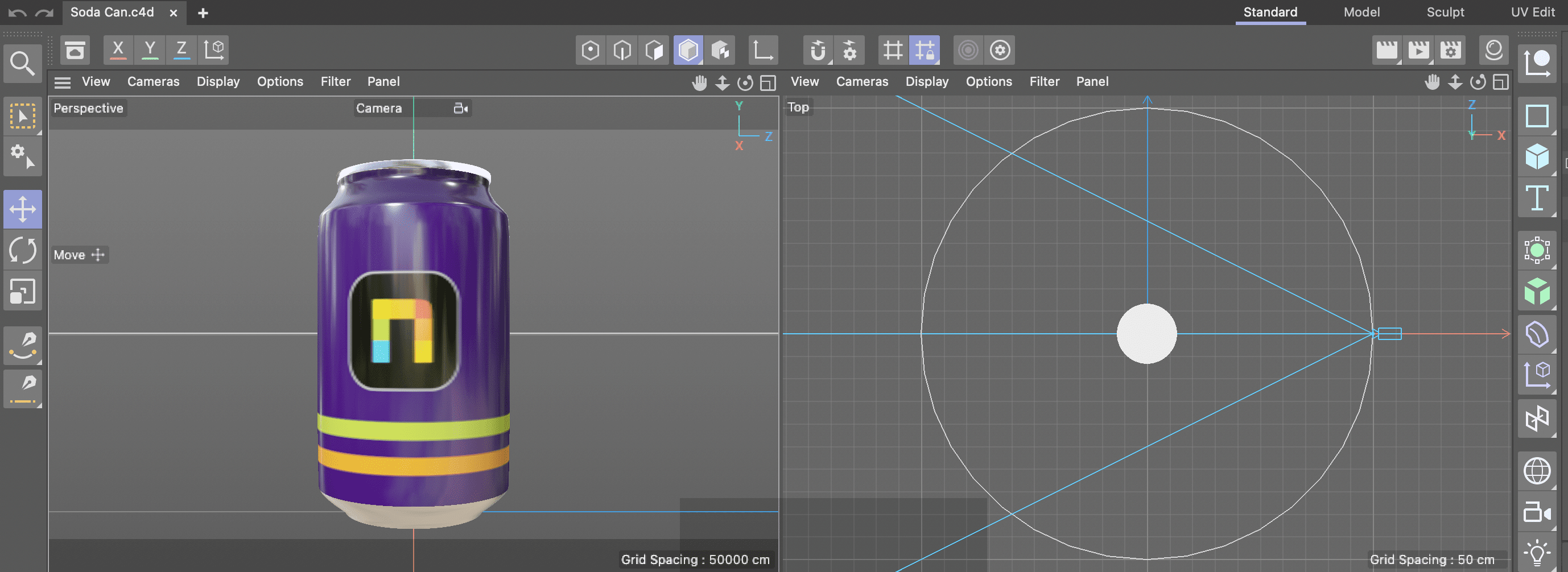
Exercise Overview
In this exercise you’ll be introduced to the workflow for using Cinema 4D with After Effects. You’ll also be introduced to the C4D interface, its tools and some common 3D terminology.
Previewing the Final Video
This project does not have a final video.
Getting Started
In Adobe After Effects, if you have a project open, choose File > Save.
Choose File > Close All Projects.
Choose File > Open Project and:
- Navigate to Desktop > Class Files > C4D in AE Class > Intro to C4d
- Double–click on Intro to C4D.aep to open it.
Choose File > Save As and:
- Name the file Your Name - Intro to C4D
- Save it into Desktop > Class Files > C4D in AE Class > Intro to C4D.
Opening C4D Lite for the First Time
After Effects includes a free license for C4D Lite. In order to use C4D Lite Maxon requires that you also have a MAxon ID in addition to your Adobe Creative Cloud Logon. The first time you open C4D Lite you have to do so through After Effects to activate the license.
In After Effects, press the spacebar to preview the Noble Soda composition.
Notice that the can is a 3D model that rotates in front of an animated background.
With the Noble Soda Composition active, click on the Soda Can Animation layer to select it.
Choose Edit > Edit Original or press Cmd–E (Mac) or Ctrl–E (Windows) to open the 3D model in Cinema 4D Lite.
NOTE: You can also select the C4D file in the Project panel and use the same command.
If this is your first time opening C4D Lite, you will be prompted to enter or create a Maxon ID and then activate your free license of C4D Lite.
Complete the activation or sign-up process and continue on to C4D.
From now on, Cinema 4D Lite can be opened up directly, just like any other application on your computer.
What is Cinema 4D Lite?
Cinema 4D (C4D) is a 3D modeling and animation program created by Maxon Corporation. It is a full featured 3D modeling and animation application and can be used for technical and medical visualizations, explainer videos, advertising, and even video games. Though it is mostly used for the creation of Motion Graphics due to its very strong integration with After Effects and its own MoGraph tools.
Cinema 4D Lite is a free version of the application included with your After Effects install. It is limited when compared to the full version though it is still quite feature rich and many AE user find that they can still create very impressive 3D work even with just the Lite version.
NOTE: when in doubt, simply right-click (or Ctrl-click) on just about any object or menu, and choose “Show Help” — and Cinema4D will take you to the relevant help article, written in plain language.
In addition to its own ability to create 3D models, C4D Lite can also serve as an intermediary, allowing you to import a variety of 3D files into After Effects.
Cineware is the plugin for After Effects that allows you to use Cinema 4D files directly in your AE projects. With Cineware, you can import and work with 3D objects, scenes, and animations created in Cinema 4D directly in AE, without having to render them out first. This makes it easier to work with 3D elements in your After Effects projects. With Cineware, you can add 3D elements into your compositions, add additional 2D elements, and use the powerful compositing tools in After Effects to create compelling visual effects and animations.
The Cinema 4D Lite Interface
If you have never used a 3D application before the interface can seem quite daunting. But with a little guidance and some practice it will all start to make sense.
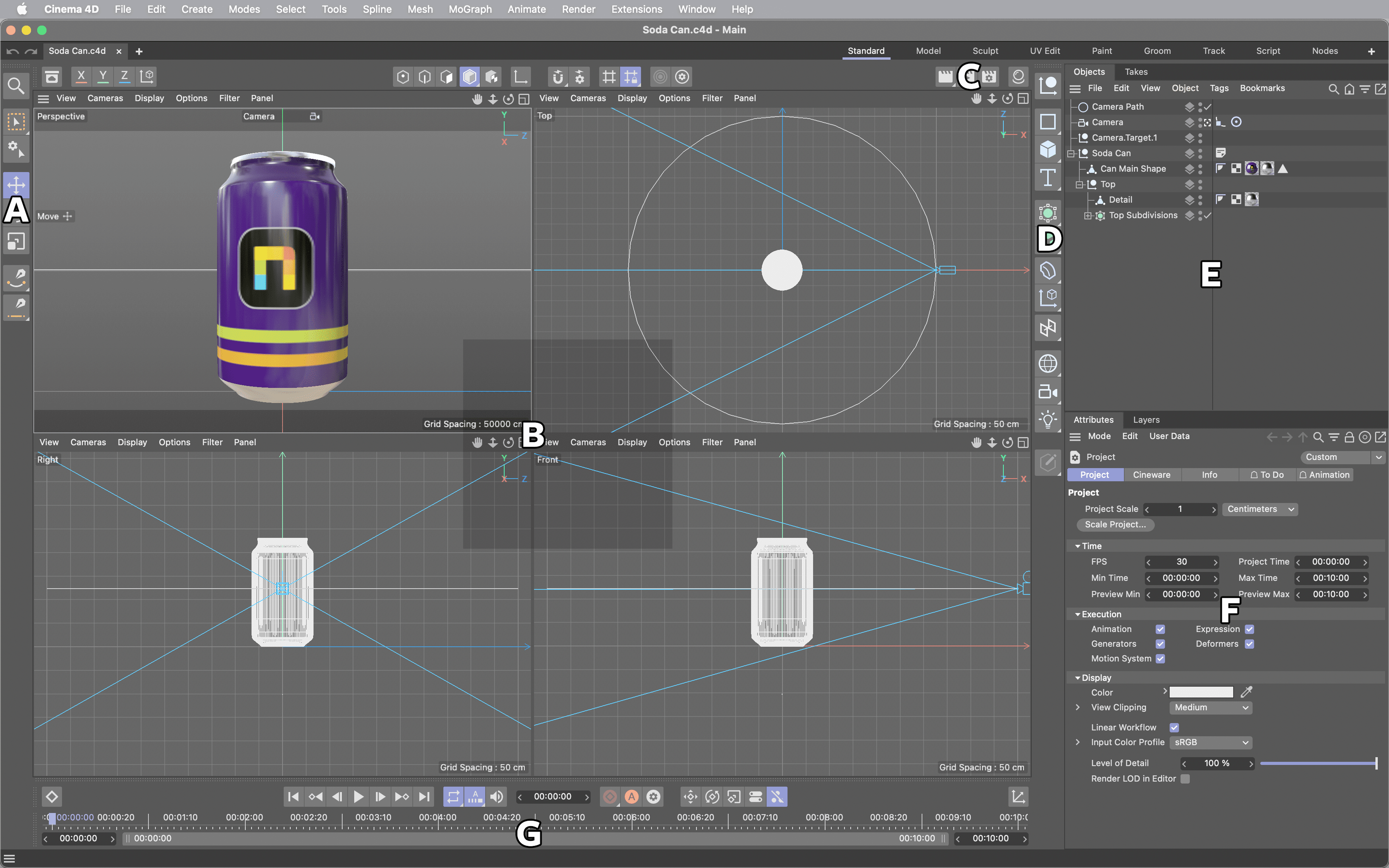
A: Tools Menu, B: Views & Viewports, C: Render Menu, D: Create Menu, E: Object & Take Managers, F: Attribute & Layer Managers, G: The Animation Palette
Tools Menu: In addition to the Move, Rotate and Scale Tools you will find Selection and Spline Drawing tools here as well.
Views & Viewports: You can open as many view panels as you like. Each view panel has its own display settings. A view panel can display up to four viewports (views of a scene), each with its own display settings.
Render Menu: The Render menu contains all the options you need to render a picture or animation. You can define several render presets, such as for preview and for final rendering. This saves you having to change the settings one by one each time. Using the render settings, you can also switch on effects such as Multi-Pass rendering.
Create Menu: This menu contains most basic objects that can be created in Cinema 4D Lite. Objects are the most indispensable items in Cinema 4D Lite. After all, objects are the most-rendered items in 3D, be it parametric primitives, polygon objects or a variety of other types of objects. Additionally, there are many helper objects that can be used to form or duplicate your actual objects or make renderable objects from splines, and much more. Some objects even share nearly identical properties, e.g., those of the Basic tab. All object properties for a selected object will be displayed and can be edited in the Attributes Manager.
Object Manager: The Object Manager is the control center for all objects in the scene including their tags.
Take Manager: The Take function allows you to store various animations, render settings, camera perspectives and a variety of other variations in a single file.
Attribute Manager: The Attribute Manager gives you quick access to almost every parameter in CINEMA 4D Lite, including the parameters of objects, tools, tags, materials, etc. In addition, you can animate directly in the Attribute Manager without ever opening the Timeline! You can animate any parameters that have a circle next to their name.
Layer Manager: The layer concept helps you to easily manage complex scenes, such as imported CAD files which often contain thousands of polygon objects. So what are layers? Layers are nothing other than groups of scene items that can be controlled together.
The Animation Palette: The Animation Palette contains the most-used navigation and recording tools from the Timeline itself. The three main elements of the palette are: The Timeline Ruler, The Powerslider and Navigation & Mode icons.
Navigate around the Viewport with 123
In C4D Lite you can navigate around a scene using a mouse and the 123 keys. Or if you prefer, you can use the onscreen Navigation  buttons located in the upper right-hand corner of any Viewport.
buttons located in the upper right-hand corner of any Viewport.
1 key + left mouse button (or in upper right-hand corner): translate view – takes you left, right up and down. Like the Hand tool in Adobe programs.
1 key + right mouse button or 2 key + left mouse button: zoom in/out of the view. Like Zoom tool in Adobe.
3 key + left mouse button or 3 key + right mouse button: rotate around the visual axis
NOTE: If you use the 1, 2, & 3 keys with your mouse, the zoom and rotation will be based on your mouse position. That doesn’t happen with the onscreen icons at the top of the Viewport—the rotation and zoom will always be centered when you use these.
In the Top viewport use the 1, 2, & 3 keys and your mouse to change the viewport display.
Choose View > Frame Default from the Viewport menu to reset the view.
NOTE: Cmd–Shift–Z (Mac) or Ctrl–Shift–Z (Windows) is the keyboard command to undo viewport changes.
Move-rotate-scale with ERT
The E, R and T keys activate the Move, Rotation, and Scale Tools. Click each to activate that tool for any selected object. Alternatively, you can click on each tool individually in the Tools Menu.
Drag (Scrub) the playhead back and forth in the Timeline to see the animation of this scene. The Camera is spinning around the can, don’t worry about how this is done, we’ll look at that later.
Make sure the playhead is at the beginning of the timeline 00:00:00
In the Object Manager Cmd (Mac) or Ctrl (Windows) click on the plus or minus icon to the left of the Soda Can object until you can see all of its children.
Still in the Object Manager, click on the Soda Can null object to select it.
In the Attribute Manager, click on the Coord. tab. You can see the Position, Rotation and Scale attributes here.
Press R on your keyboard or click on the Rotate tool to activate it.
In the Top viewport place your cursor over the circle around the Soda Can object.
Drag the can until the Noble Desktop logo is facing the camera head on in the Perspective view.
NOTE: In C4D rotation is denoted in terms of H, P and B (Heading, Pitch & Bank). H is the rotation around the Y axis, P around the X axis and B around the Z axis.
Changing Position, Rotation or Scale
The camera is moving around the soda can using a feature of C4D called a align to Spline. This allows a camera or other object to follow a specific path around the scene. Adjusting the spline will change the camera’s movement but this is why the camera in this scene cannot be manually adjusted. You can however move any other object in this scene around.
In the Object Manager click on the Camera Path spline to select it.
Press R on your keyboard or click on the Rotate tool to activate it.
In the Right viewport hover your cursor over the blue circle on the can until it turns white.
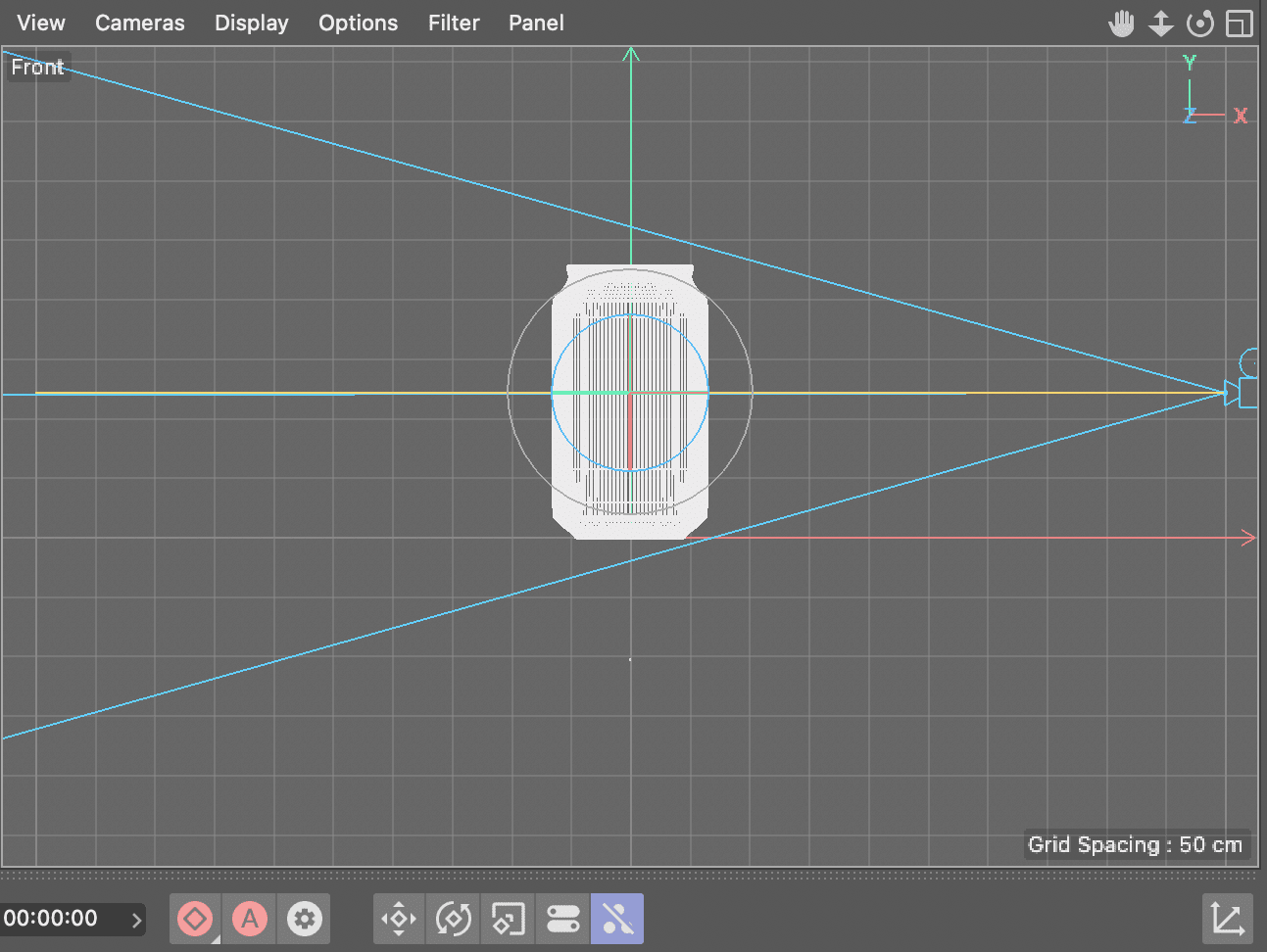
Drag the circle until you are looking at a top down view of the can in the Perspective view. In our example we had a R.B of -25.
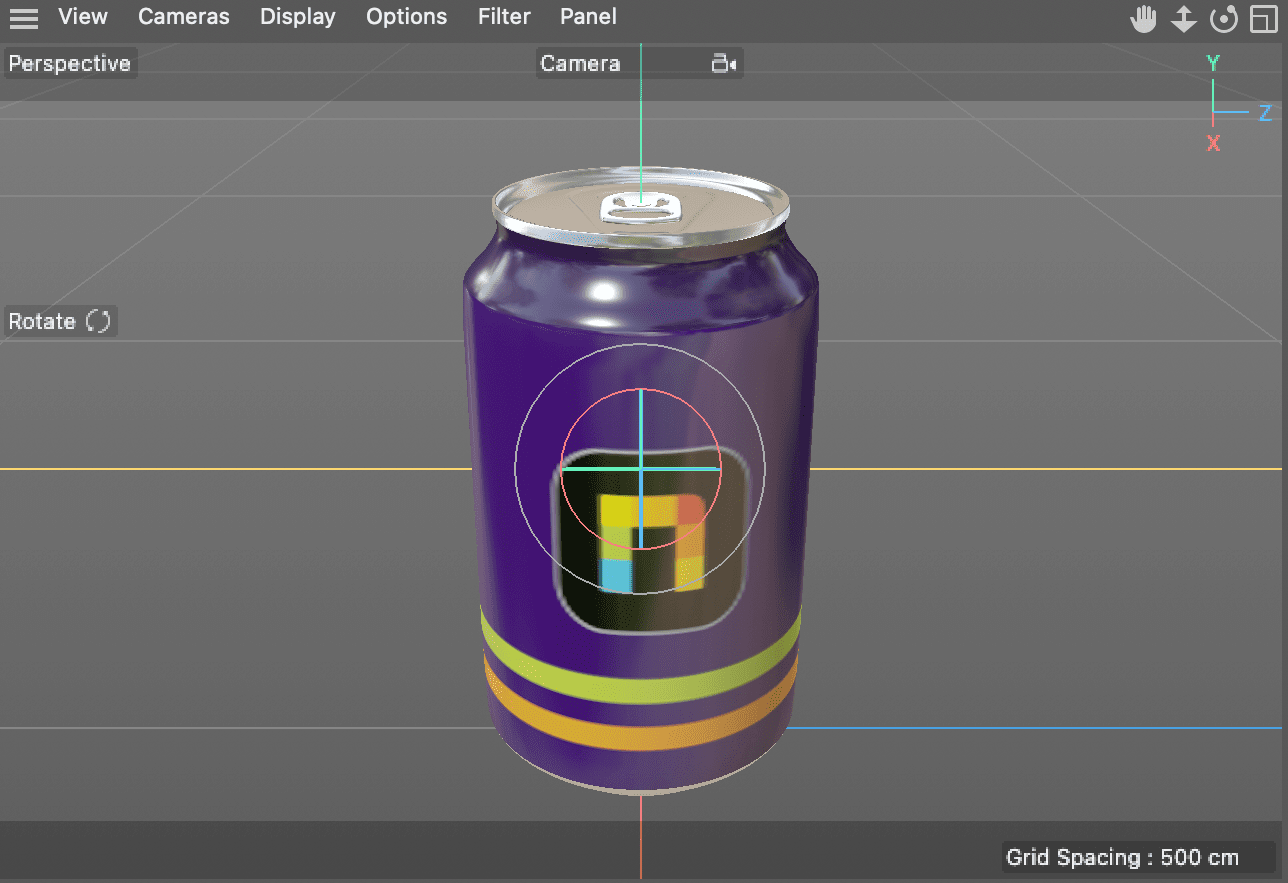
Drag (Scrub) the playhead back and forth in the Timeline to see the animation of this scene.
Make sure the playhead is at the beginning of the timeline 00:00:00
Locating Keyframes
When an object is selected in the Object Manager, its keyframes are visible on the Timeline.
In the Object Manager click on the Camera Path object.
Notice that there are no keyframes (they would be visible as white rectangles) on the Timeline.
Maybe the keyframes are on the camera itself? Click on the Camera object to select it.
- No, keyframes are present here either.
In the Object Manager, hover your cursor over the icons to the right of the Camera object. A tooltip with the name of each tag will pop up as you hover over them.
Locate the icon named Align to Spline Expression and click on it. Two white keyframe icons (once at 00:00:00 and the other at 00:05:00) are revealed on the timeline.
NOTE: Like in After Effects, keyframes can be dragged left or right on the Timeline to change the timing of an animation. Additionally they can be copied, pasted, or deleted with a Ctrl–click (Mac) or Right–click (Windows) action.
Now that we know where the keyframes are we can adjust them. Or in this case, we will delete them entirely.
Make sure the playhead is at the beginning of the Timeline.
In the Object Manager, click on the Align to Spline Expression tag next to the Camera object.
Press Delete (Mac) or Backspace (Windows) to delete it.
In the Object Manager click on the Camera Path spline object to select it and press the Delete (Mac) or Backspace (Windows) key on your keyboard.
Press Cmd–S (Mac) or Ctrl–S (Windows) or choose File > Save Project.
Animating Transform Properties
The camera animation in this scene was OK but it will be a much better and more visually appealing animation if instead of a moving camera it was the can that was moving.
Since the can is already in the right position, scale and rotation for the end of the animation we will animate it backwards creating the last keyframe of the animation first.
Move the Playhead to where you want to create the ending keyframe of the animation. In this exercise that is going to be at 1:00 (1 second).
NOTE: In Cinema 4D just typipng 1 into the time field and pressing Return (Mac) or Enter (Windows) on the keyboard will move the time indicator to 1 second.
In the Object Manager click on the Soda Can to select it.
The Soda Can is a null object that is the parent of the entire soda can model.
What is a Null Object
A null object in Cinema 4D is an invisible placeholder used to control and organize other objects in a scene. Null objects can be used as a parent object for other objects, allowing you to control the position, rotation, and scale of multiple objects at once. Null objects can also be used as a reference point for cameras and lights, making it easier to create complex animations. They do not affect the final render and are only used for organizational and control purposes.
In the Attribute Manager click on the Coordinates tab.
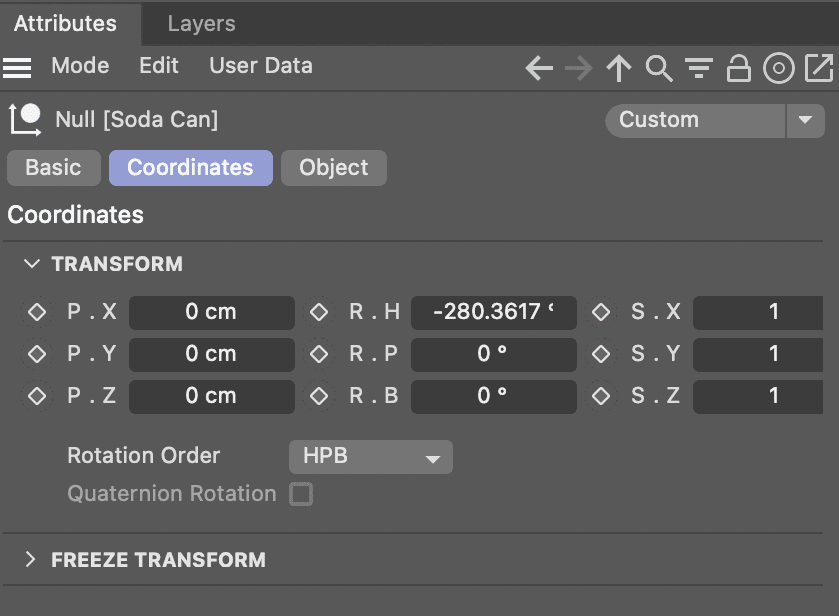
Change the Rotation Order menu to XYZ. This doesn’t actually affect the animation it just switches to a coordinate system that we are more familiar with.
Click the gray diamond
 next to the three Rotation (R.X, R.Y, R.Z) and Scale (S.X, S.Y. S.Z) attributes to create keyframes for each of them.
next to the three Rotation (R.X, R.Y, R.Z) and Scale (S.X, S.Y. S.Z) attributes to create keyframes for each of them.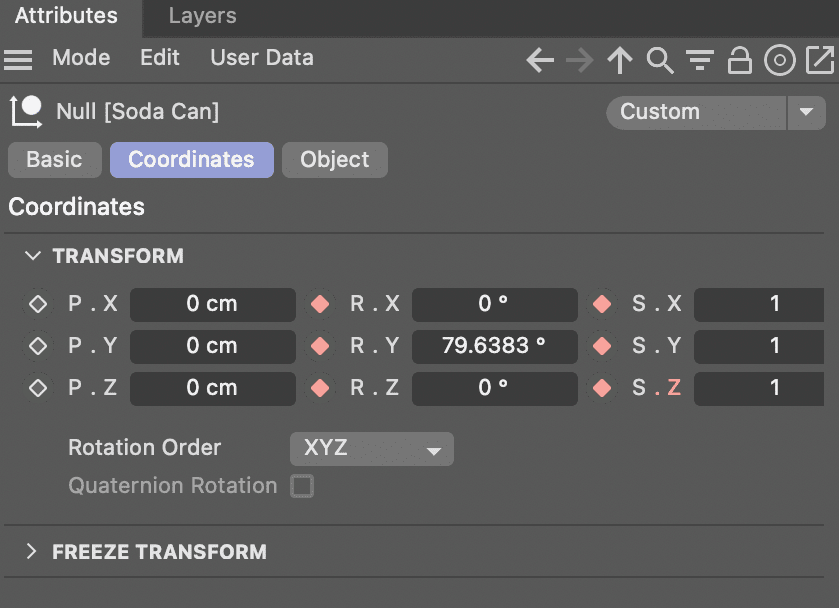
Move the Time Indicator (most video programs all it a playhead) to the beginning of the timeline.
Change the Attributes to the following values:
Rotation Value Scale Value R.X 360 S.X 0 R.Y 0 S.Y 0 R.Z 240 S.Z 0 Click the diamonds
 (the red outlines indicate there is no keyframe at this time) next to each attribute to create new keyframes for them.
(the red outlines indicate there is no keyframe at this time) next to each attribute to create new keyframes for them.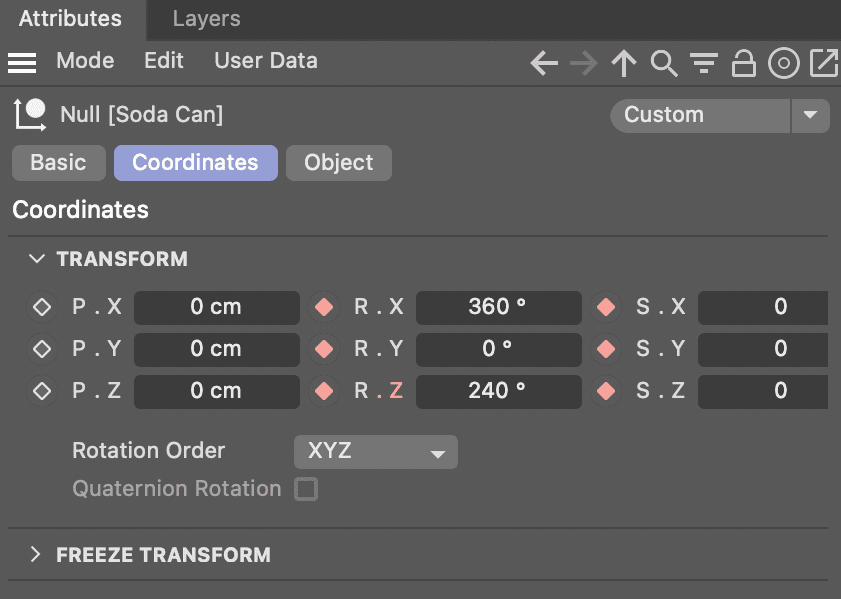
Press the Play Forwards button or F8 on your keyboard to preview the animation.
Press the Pause button or F8 again to stop the playback.
The can rotates and scales from the bottom because this this is where its axis (called an anchor point in AE) is located.Press Cmd–S (Mac) or Ctrl–S (Windows) or choose File > Save Project.
Changing the Axis of an Object
In Cinema 4D, the axis of an object refers to the virtual point that represents the orientation of the object in 3D space. Each object has its own axis, with the origin of the axis being the pivot point and origin of all transformation (position, rotation, scale). This point can be edited when in Axis Modification mode.
Move the time indicator to any time after the animation of the can has finished.
Click the
 button to enter axis modification mode.
button to enter axis modification mode.Click the Move
 tool to activate it.
tool to activate it.Drag the axis point from the bottom of the can to the middle.
Click off the Enable Axis button to leave axis modification mode.
Press the Go To Start button or Shift–F on the keyboard.
Press the Play Forwards button or F8 on your keyboard to preview the animation.
Press Cmd–S (Mac) or Ctrl–S (Windows) or choose File > Save Project.
Optional Bonus: Editing Textures in Photoshop
In Cinema 4D, a material is a set of visual properties applied to an object that determines how the object will look and react to light. A material includes properties like color, texture(bump), reflectivity, transparency, and more. A material can be created procedurally, using only the effects inside C4D, or from an external image. Once a material is created and applied, it can be edited and adjusted to achieve the desired look for the objects in the scene.
The can label textures used in this project is an external Photoshop file. Just like when working with files in AE, linked texture files can be edited and the appearance of your models will update in Cinema 4D.
Locate the soda can’s material tags. Tags are located to the right of each object in the Object Manager
Double–click on the tag you want to edit. Visual materials like labels and decals are usually in the Color property of a material.
In the Attribute Manager, click on the arrow next to the Texture attribute and choose Edit Image. This command will open Photoshop.
In Photoshop, change the file and save it.
In C4D, click on the arrow next to the Texture attribute and choose Reload Image.
Press Cmd–S (Mac) or Ctrl–S (Windows) or choose File > Save Project.
INFORMATIONAL: What is the Align to Spline Expression?
The Align to Spline Expression icon you deleted earlier in the lesson is called a tag. In Cinema 4D, a tag is a small piece of information or data that can be added to an object. These tags can be used to specify certain properties or attributes of an object, such as its material, animation or even whether it is selectable or not. For example, a tag could be used to specify that an object follow a specific path (like align to spline) or a tag could be used to specify that an object is the target of a camera or light. You can attach different types of tags to objects, and each tag type modifies the object in a specific way.
In short, tags in Cinema 4D are a way to add extra information to an object, which can be used to change or control its properties or behavior.
INFORMATIONAL: What is a Spline?
A spline object in Cinema 4D is a 2D straight line or curve that can be used to define the shape or path of other objects. Splines can be created using the Pen tool, the shape tools, or by importing vector graphics from applications like Adobe Illustrator. They are made using line segments that connect at points called vertices (vertex is singular) that can be manipulated and edited to change their shape. In Cinema 4D, splines can be used to define the paths of objects such as sweep objects, loft objects, and more. They can also be used as a basis for deformers to change the shape of objects, and they can be used as guides for constraint-based animation.